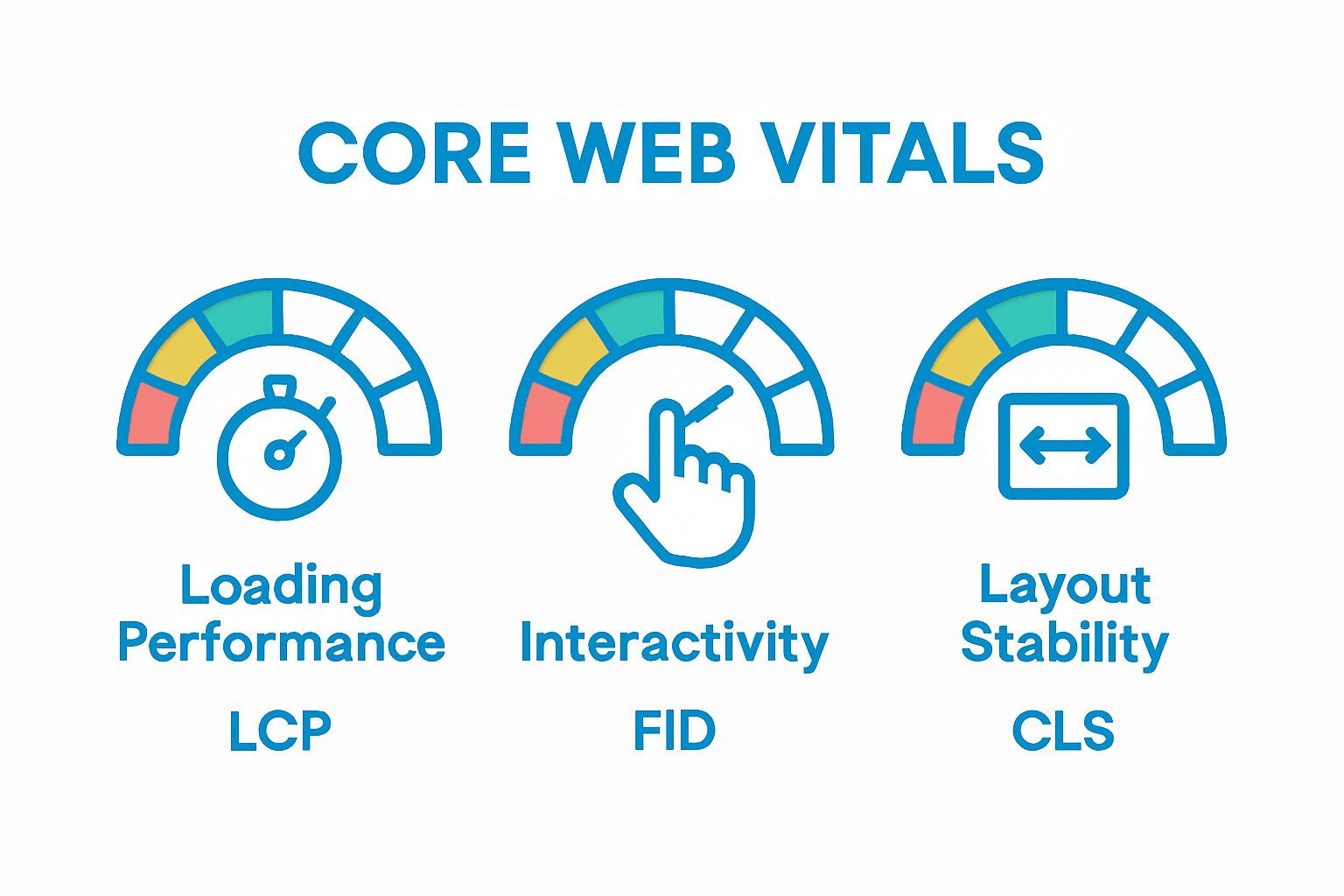Page experience signals are becoming the backbone of how websites are ranked and trusted online. You might expect that content is king when it comes to climbing search results. But Google now uses technical page experience metrics as core ranking factors and these numbers often outweigh what your page says. This shift means even the best-written pages can lose out if the site feels slow, unstable, or clunky, turning the spotlight on something most website owners overlook until it’s too late.
Table of Contents
- What Are Page Experience Signals And Why Do They Matter?
- How Page Experience Signals Impact User Engagement
- Measuring And Analyzing Page Experience Signals Effectively
Quick Summary
| Takeaway | Explanation |
|---|---|
| Page experience signals impact SEO rankings | Search engines prioritize page experience signals as essential for webpage ranking. Improving these metrics can enhance visibility. |
| Core Web Vitals are crucial metrics | Largest Contentful Paint, First Input Delay, and Cumulative Layout Shift are key indicators of performance, impacting user satisfaction and engagement. |
| Fast loading boosts user engagement | Quick and responsive pages lead to lower bounce rates and higher conversions, directly affecting business outcomes. |
| Holistic optimization combines tech and design | Balancing technical performance with user experience improves engagement and meets user expectations while aligning with search engine criteria. |
| Regular audits enhance page performance | Consistently measuring and analyzing page experience signals allows for targeted improvements and better user interactions. |
What are Page Experience Signals and Why Do They Matter?
Page experience signals represent a comprehensive set of metrics that evaluate how users interact with and perceive a webpage, focusing on the overall quality of their digital experience. These signals go beyond traditional content analysis, examining technical aspects that directly impact user satisfaction and engagement.
The Core Components of Page Experience
At their foundation, page experience signals encompass several critical technical and user interaction elements that search engines like Google use to assess webpage quality. Search engine optimization strategies now prioritize these signals as crucial ranking factors. The primary components include:
- Loading Performance: How quickly the page becomes visible and interactive
- Interactivity: The responsiveness of the webpage to user inputs
- Visual Stability: Preventing unexpected layout shifts during page load
Understanding User Experience Impact
Search engines recognize that technical performance directly correlates with user satisfaction. When a webpage loads quickly, responds smoothly, and provides a stable visual experience, users are more likely to stay engaged, explore content, and complete desired actions.
This connection means page experience signals are not just technical metrics but direct indicators of potential user behavior.
Technical performance becomes a critical differentiator in competitive digital landscapes. Research from the International Web Association emphasizes that users increasingly expect seamless, fast, and reliable web interactions. Websites that fail to meet these expectations risk losing potential visitors, reducing engagement, and ultimately suffering lower search rankings.
By understanding and optimizing page experience signals, website owners can create more compelling digital experiences that not only satisfy users but also align with search engine ranking algorithms. Read our comprehensive guide on landing page optimization to dive deeper into strategies that enhance these critical performance metrics.
The Key Components of Page Experience Signals Explained
Page experience signals are intricate technical metrics that search engines use to evaluate website performance and user interaction quality. Understanding these components helps website owners create more engaging and search engine friendly digital experiences.
Core Web Vitals: The Technical Foundation
Search engines like Google have defined specific metrics known as Core Web Vitals that measure critical aspects of webpage performance.
 Web development experts from Google highlight three primary technical measurements:
Web development experts from Google highlight three primary technical measurements:
- Largest Contentful Paint (LCP): Measures loading performance by tracking how quickly the main content becomes visible
- First Input Delay (FID): Evaluates interactivity by assessing how rapidly the page responds to user interactions
- Cumulative Layout Shift (CLS): Tracks visual stability by monitoring unexpected content movements during page load
Beyond Technical Metrics: User Experience Considerations
While technical performance is crucial, page experience signals extend beyond pure technical measurements. Usability research indicates that user perception involves multiple interconnected factors. These include not just speed and responsiveness, but also content readability, intuitive navigation, and overall design coherence.
Websites must balance technical optimization with meaningful user experience design. This means creating pages that load quickly, respond smoothly, maintain visual consistency, and provide clear, accessible content.
Below is a table summarizing the three Core Web Vitals, highlighting their focus and what each metric measures in terms of user experience.
| Core Web Vital | What It Measures | User Experience Focus |
|---|---|---|
| Largest Contentful Paint (LCP) | Loading performance: how quickly main content becomes visible | Perceived speed |
| First Input Delay (FID) | Interactivity: how fast the page responds to user input | Responsiveness |
| Cumulative Layout Shift (CLS) | Visual stability: how much unexpected movement occurs during load | Layout consistency |
Strategic Optimization Approach
Optimizing page experience signals requires a comprehensive strategy. Website owners should regularly audit their digital properties, using tools that measure Core Web Vitals and gather user interaction data. Learn more about technical SEO strategies to develop a robust approach to page performance and user experience enhancement.
How Page Experience Signals Impact User Engagement
Page experience signals are not just technical measurements but powerful drivers of user behavior and digital interaction. Understanding their profound impact helps websites create more compelling and engaging online experiences that retain and convert visitors.
Psychological Mechanisms of User Interaction
Users form split second impressions about websites based on performance and design. Content engagement research reveals that technical factors like loading speed and visual stability directly influence user psychology. When a webpage loads quickly and responds smoothly, users experience a sense of efficiency and professionalism that encourages continued exploration.
The psychological mechanisms driving user engagement through page experience signals include:
- Cognitive Fluency: Smooth, predictable interfaces reduce mental effort
- Emotional Response: Fast, stable pages create positive emotional associations
- Trust Perception: Technical performance signals website credibility
Quantifiable Impact on User Behavior
Engagement metrics demonstrate the tangible consequences of page experience signals. Websites with superior performance consistently show higher:
- Reduced bounce rates
- Increased time on page
- Higher conversion percentages
- More page views per session
These metrics translate directly into business outcomes. A millisecond delay can significantly decrease user satisfaction and potentially drive potential customers to competitor websites.
Strategic User Experience Design
Successful digital experiences require holistic optimization that goes beyond technical performance. Learn more about personalization strategies that complement technical improvements and create more engaging user journeys. By understanding how page experience signals influence user psychology, websites can design more intuitive, responsive, and satisfying digital interactions that meet both user expectations and search engine requirements.
Measuring and Analyzing Page Experience Signals Effectively
Measuring page experience signals requires a systematic approach that combines technical analysis, user behavior tracking, and strategic interpretation. Understanding how to effectively collect and evaluate these metrics enables websites to make data driven improvements that enhance overall digital performance.
Technical Measurement Tools and Approaches
Web performance experts from Google recommend utilizing a combination of lab and field data collection methods. These approaches provide comprehensive insights into page experience signals by examining both controlled testing environments and real world user interactions.

Key measurement tools and techniques include:
This table provides a comparison of key technical measurement tools and approaches for gathering and analyzing page experience signals, including their descriptions and unique strengths.
| Tool/Approach | Description | Unique Strength |
|---|---|---|
| Synthetic Testing Tools | Evaluate performance in a controlled environment | Consistent, repeatable measurements |
| Real User Monitoring (RUM) | Collects data from actual users on real devices | Reflects real-world user experience |
| Browser Developer Tools | Built-in browser diagnostics and real-time analysis | Immediate, detailed troubleshooting |
- Synthetic Testing Tools: Controlled environment performance evaluation
- Real User Monitoring (RUM): Actual user interaction data collection
- Browser Developer Tools: Immediate performance diagnostic capabilities
Interpreting Performance Metrics
Successful page experience signal analysis goes beyond raw numbers. Website owners must understand the contextual implications of each metric and how they interconnect to influence overall user experience. Critical metrics like Largest Contentful Paint (LCP), First Input Delay (FID), and Cumulative Layout Shift (CLS) require nuanced interpretation.
Each metric provides unique insights:
- LCP: Reveals content loading speed perception
- FID: Demonstrates interactive responsiveness
- CLS: Indicates visual stability and design consistency
Strategic Performance Optimization
Transforming measurement into meaningful improvements requires a holistic approach. Learn more about monitoring SEO performance to develop comprehensive strategies that integrate page experience signal analysis with broader digital marketing objectives. By continuously tracking, analyzing, and refining these signals, websites can create increasingly sophisticated and user friendly digital experiences that meet evolving technological standards.
Supercharge Your SEO Success by Mastering Page Experience Signals
Struggling to keep your website visitors engaged because of technical slowdowns or unstable layouts? If you read about Core Web Vitals and page experience signals in our latest article, you know how even small issues in loading speed or interactivity can push potential customers away. That single missed optimization can cost you rankings, leads, and sales you deserve. Imagine how much better your results could be if every vital metric on your site was fine-tuned using trusted solutions proven by top SEO consultants.
Take control today. With the #1 Keyword Cannibalization Tool, you do more than fix content overlap. You reveal new insight into how your landing pages, site structure, and technical setup affect user perception and search engine trust. See how powerful actionable reports from RankAligner can help you address pain points just like those described in our landing page optimization guide. Try it now and give your website the experience boost your audience expects before your competition claims your spot.
Frequently Asked Questions
What are page experience signals?
Page experience signals are a set of metrics that evaluate how users interact with and perceive a webpage, focusing on technical aspects like loading performance, interactivity, and visual stability that impact user satisfaction.
Why do page experience signals matter for SEO?
Page experience signals are crucial for SEO because they influence search engine rankings. Websites that provide a better digital experience through fast loading times, smooth interactivity, and stable visual layout are more likely to rank higher in search results.
What are the Core Web Vitals?
Core Web Vitals are specific metrics defined by Google to measure essential aspects of webpage performance, including Largest Contentful Paint (LCP) for loading speed, First Input Delay (FID) for responsiveness, and Cumulative Layout Shift (CLS) for visual stability.
How can I optimize my webpage for better page experience signals?
You can optimize your webpage by regularly auditing your site performance, using tools to measure Core Web Vitals, improving loading speeds, ensuring smooth interactivity, and creating a visually consistent layout that enhances user experience.
Recommended
- Landing Page Optimization Tips for 2025: Strategies That Convert
- Understanding Personalization and SEO for Better Engagement – Rank Aligner – Your Ultimate Keyword Cannibalization Problem Solver
- SEO Tips for Ecommerce: Proven Strategies for 2025
- Semantic Search Explained: Boost SEO Results in 2025

